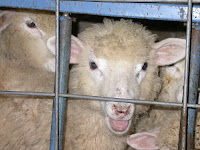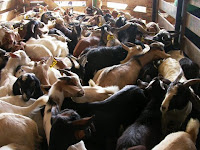
Among some religions and cultures, lamb and goat are favored meats at Easter time. This year, Eastern Orthodox (Greek) and Western (Roman) Easter will be on the same day: April 8. Next year, they will be over a month apart.
Orthodox Easter is usually later than Western Easter, because the date is calculated differently. Eastern Orthodox Christians come from a variety of ethnic backgrounds: Greek, Russian, Egyptian, Romanian, Serbian, Ukrainian, Armenian, Bulgarian, Georgian, Albanian, Ethiopian, Syrian, and American.
What do the markets want?According to
www.sheepgoatmarketing.info, the type of lamb wanted at Western Easter is 30 to 45 lbs. live weight, milk fed, and fat. A slightly larger lamb is prefereed for Greek Easter, 40 to 50 lbs. live weight.
For Western Easter, goats should be less than 3 months of age, 20 to 50 lbs. live weight. ~30 lbs. is optimal for most buyers. A slightly larger milk-fed kid is preferred for Greek Easter, ~35 lbs.
For Passover, which is April 3-10, a 30 to 50 lb. milk-fed, fat lamb is preferred by buyers. The next Muslim holiday is Mawlid al-Nabi, the Prophet Muhammad's birthday. It is March 31.
When should you sell?It can be a challenge to know when the best time to sell lambs and kids for the Easter holidays is. To help guide you in this decision, take a look at the New Holland market reports from last year's holiday season, in which Western Easter was on April 16 and Greek Easter was April 23.
March 12, 2006 |
March 29, 2006 |
March 26, 2006 |
April 3, 2006 |
April 10, 2006 |
April 17, 2006 |
April 24, 2006In 2006, a record-setting sheep and lamb sale drew nearly 4,000 head to New Holland's last big sale before Roman Easter, which depressed prices. Goat prices were also lower. Prices rebounded the week after Roman Easter, but preceeding Greek Easter.
Lamb and goat prices are affected by both supply and demand factors. While demand increases at Easter, a large supply can also depress prices in some markets.
You can post a listing of lambs and kids that you have for sale at Easter at
www.sheepgoatmarketing.info. Click on Market Inquiries, then Easter Holiday listings.
Ethnic holiday calendar (2006-2010)
Ethnic holiday calendar at sheepgoatmarketing.info





